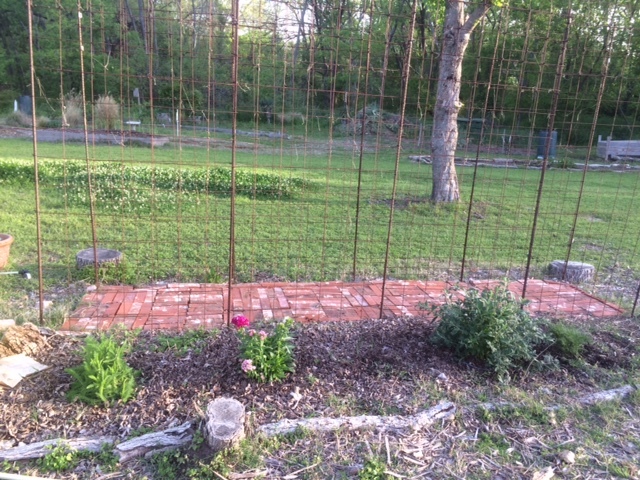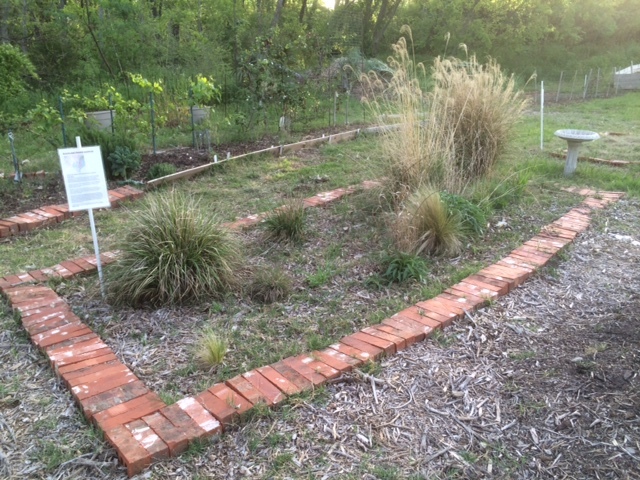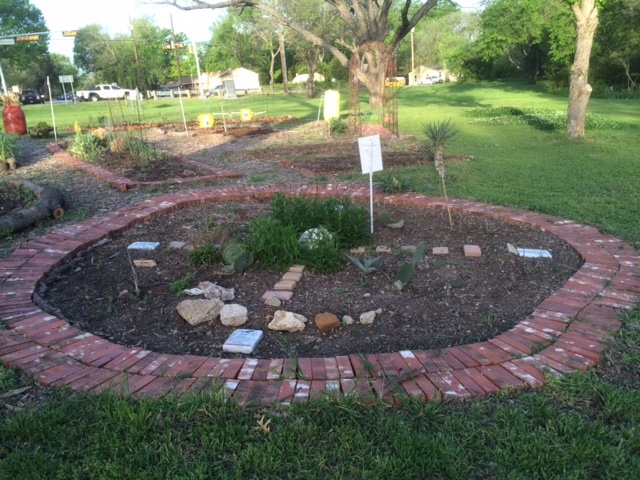
And the garden grows . . . and yes, despite all appearance of a serendipitous path, there is a big plan for the Garland Community Garden moving it forward.
Soon, on April 24, we will mark our second year down at the Garland Community Garden. It's still hard work but some of the rough edges are beginning to smooth out and management of the beds is becoming a little bit easier. Next year should even be easier. If you plan your garden well, by the end of its fourth or fifth year, it should not require a lot of long heavy hours of labor. Basically this means a mixture of about seventy-five percent perennials (most of which are native) to 25% annuals and following an organic, no-till method. Mother Nature will eventually kick in and work with you.
We now have several established beds filled with perennials that will begin their second year of life and a few that will begin their third year.
Community Gardens are difficult to sustain over the long haul. Members move, people lose interest, etc. But all in all I think that many community gardens fail because they become too much work and one of the main reasons they become too much work is because most community gardens contain 90 to 100% annual plants and still follow the old till method of overturning the soil each season. These types of gardens are extremely labor intensive. This is not true for the organic (no pesticide), no till gardens that contain a high percentage of perennial plants. They are designed to eventually let Mother Nature do most of the work. Ruth Stout had the right idea over 50 years ago. Her “no-work” gardening methods allowed Ms. Stout to garden until the she died at age 96.
CURRENT PERMANENT FEATURES OF THE GARLAND COMMUNITY GARDEN

Coming back for a repeat performance in the loofah tunnel bed we have yarrow on the left, Sweet William in the middle, a Butterfly Bush and a Pine Needle Milkweed. Soon we will be planting loofah seeds and installing a few loofah plants. Unfortunately, loofah is an annual.
- The Loofah Tunnel will begin its second year of existence. In the bed in front of its trellis we have yarrow, a Sweet William, a butterfly bush and a pine needle milkweed. This year, instead of having to build the trellis, lay the brick path, and plant seeds; all we need to do is to plant loofah seeds and install a few loofah plants.
______________________________________________________________________

The Buffalo Grass is beginning to emerge from its winter dormancy.
The Buffalo Grass Plot has already begun its second year. Last year we ordered buffalo grass seed from the Native American Seed Company and planted it the middle of March 2015. It took almost four months to get established and it was a battle keeping the Bermuda grass from chocking it out. Today, however, the turf is well established and is awakening from its winter sleep as it turns green again. Buffalo grass is the only native turf grass in North America and it has many merits to recommend it. It is extremely drought-hardy. You do not have to mow it ever and you never have to fertilize it. I have fond memories of inviting visitors last summer to slip off their shoe and walk barefoot over our Buffalo grass.
_________________________________________________________________________

A reminder of what once was. We in the DFW area are part of an eco-region known as the "Blackland Prairies." This area covers 19,400 square miles and stretches from the Red River southwesterly to San Antonio. Due to agriculture and encroaching urbanization, less than 1% of these native prairie lands and their native grasses remain.
The Blackland Prairie Sampler is another success story of plants that will come back year after year. Much of the grass in this sampler plot was grown from seed and all of it is native grass that once grew all over this area of North Texas (except for some naughty invasive non-native Bermuda grass) .
_____________________________________________________________________________________________

- The Hops Barrels - Talk about thriving on neglect! Last year after talking with several commercial hops growers in Oregon, Wisconsin and in New England, we decided to order some rhizomes and see if hops can be grown in Garland, Texas. It was recommended that we try to grow a variety called "Cascade." They did grow, but their bines seemed somewhat fragile. In late August they produced 12 hops flowers. Since we harvested the flowers, we have done nothing with the rhizomes in the two blue barrels. However, last week I noticed the bines have returned and they are much stronger looking than last year. I had considered replacing the hops with another plant, but now I think we will add more twine to allow them to climb to their fullest height this year. Below are some iris in the garden--another repeat performance from rhizomes.

_________________________________________________________________________________

The Medicine Wheel - The Medicine Wheel won't begin its second year until August 2016, but already I can see the signs of permanence showing in the face of its enduring and returning perennials. First there are two large clumps of Mexican Tarragon beginning their seasonal return. Then we have four clumps of prickly pear cactus. The prickly pear cactus was designated the official plant symbol of Texas in 1995. Found in the deserts of the American southwest, the fruits of most prickly pear cacti are edible, and have been a source of food to Native Americans for thousands of years. I am still in awe of how easy the prickly pear cactus is to propagate. Anita, Loving Garland Green’s treasurer, simply placed four sections of a prickly pear on the ground. We watered them and now, less than a year later they have multiplied. The four clumps of yarrow are five times larger than they were in August. In the next week or two we will be adding some native milkweed to the Medicine Wheel. Native Americans used the milkweed for many purposes: from material for ropes to medicine for healing.
______________________________________________________________________________
The blackberry bushes – Scattered throughout the garden are 30 blackberry bushes. The blackberry is a dependable producer here in North Texas and I wholeheartedly recommend for folks to plant four bushes in their yards (if you like to eat blackberries). I’ve found the thornless varieties with Native American names such as Arapaho, Apache, etc. are extremely productive. The four bushes in my own yard have consistently yielded 60 pounds of blackberries for the past two years. Blackberries freeze (and thaw) beautifully. They are chocked full of antioxidants and they are expensive to purchase in the grocery store—averaging $5.00 for six ounces over the year. Of course they are cheaper in season, but by December they are up to $5.98 for six ounces.
_____________________________________________________________________
The Spiral Herb Garden – Lavender and Oregano have survived from 2015. This unusual bed, patterned after herb gardens from hundreds of years ago in monasteries in Europe, begins its second year of existence in June. Today I’ll be adding an ancient herb to it—horehound (Marrubium vulgare). Horehound s a grey-leaved herbaceous perennial plant, somewhat resembling mint in appearance, and grows to 10 to 18 inches tall. Horehound has been mentioned in conjunction with medicinal use dating at least back to the 1st century BC, where it appeared as a remedy for respiratory ailments in the treatise De Medicina by Roman Aulus Cornelius Celsus. The Roman agricultural writer Columella lists it as a remedy for expelling worms in farm animals in his important first-century workOn Agriculture.Since then, horehound has appeared for similar purposes in numerous herbals over the centuries. More recently a 2011 study concluded that the essential oil of M. vulgare contains potent antimicrobial and anticancer properties. Also in 2012 another study found marrubiin, one of the primary active compounds found in horehound to possess antidiabetic, antiatherogenic and anti-inflammatory properties.
____________________________________________________________________________

Soon we will add soil to top this off and plant some vegetables in the keyhole garden. This design is especially handy for those who don't like to bend over. By providing a hard surface around its perimeter, this garden space becomes wheelchair accessible. Unlike other gardens, the plants in the keyhole are crowded very close to each other. How close? Deb Tolman told me last year that she has seen 50 tomato plants growing and producing like crazy in one of these beds.
The Keyhole Garden – The keyhole garden holds a special place in my heart. It was the first significant donation to the garden from Leon Smith. As you can see from how large the vegetables grow in this bed, the keyhole design is especially efficient. Its soil contents are similar to that of the hugelkultur—large rotten logs comprise the bottom layer, smaller twigs, leaves and other organic matter comprise the subsequent layers, topped off with a layer of garden soil. The frame for this bed was made by Leon Smith of Keyhole Garden in Clifton, Texas. Read more about Leon Smith and Keyhole gardens at http://keyholefarm.com
COME VISIT THE GARLAND COMMUNITY GARDEN TO ENJOY, LEARN AND PARTICIPATE
And while you are there, pull a weed or two or water a plant that appears to be thirsty. Stop by one of our annual beds. We have recently planted a tomato and basil plot. Read some of the signs in this bed and you may be surprised to learn that North America has 4,000 species of native bees and the honeybee is not one of them. The Europeans brought the honeybee to North America over three hundred years ago.
Furthermore, the honeybee is of no use when it comes to tomato flowers, which have no nectar. It is our native bees (the bumblebee and the Mason bee) along with the wind who pollinate tomato flowers. We invite you to come to the garden and learn more about our native bees.
Speaking pollinators, Loving Garland Green members are in the process of installing a butterfly garden to help promote our Mayor in his efforts to encourage our residents to plant native milkweed to support the Monarch butterflies. We have planted some native milkweed in this plot and currently have three varieties in various stages of development: 1) A seed bed of Asclepias syriaca 2) Seedlings of Asclepias tuberosa and Asclepias viridis.
WE HOPE TO SEE YOU THERE.